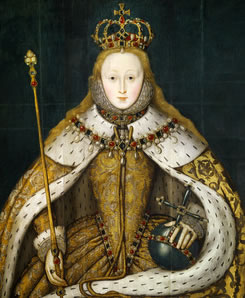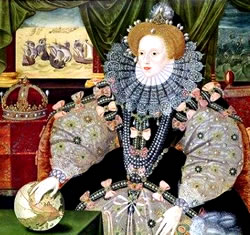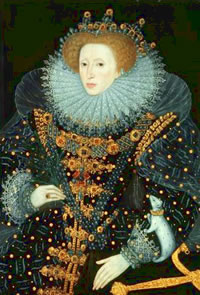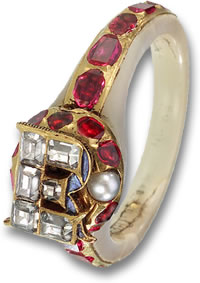|
Reviewed By Andreas Zabczyk
Queen of Pearls Queen Elizabeth I Coronation Portrait
Monarchs throughout history and all over the globe are known for their incredible collections of jewels. Some nobles like to pile on the bling where others prefer a less loud look. One queen who is remembered for her elaborate costumes and jewelry was Queen Elizabeth I, the Tudor queen who ruled Britain from 1558 until 1603. She was arguably the greatest British monarch who led the nation during its golden age. Elizabeth Tudor was the daughter of Henry VIII and Anne Boleyn, the second of his six wives. Elizabeth was said to have been a quiet but bright child. Her reserve is not surprising considering that her father was disappointed at her birth, since he had been hoping for a male heir, and that her mother was executed by her father when she was just an infant. Upon her father's remarriage to Jane Seymour, Elizabeth was declared illegitimate. It was not until years later that her father's sixth wife, Catherine Parr paid attention to Elizabeth's education. According to an outrageous conspiracy theory, Elizabeth I was really a man in disguise. When she was ten years old, the young Elizabeth was sent away to escape bubonic plague, but some think that she may have passed away and been replaced by a boy in an elaborate plan to appease Henry VIII. Bram Stoker wrote in "Imposters" that she really died and her male friend stood in for her. The fact that she never married and the discovery of the coffin of a finely dressed Tudor girl helped to increase speculation. She was known to have stated that she had "the heart and stomach of a man", which further fueled the rumors, along with the facts that she would rarely allow doctors to tend to her and no autopsy was allowed when she died. Could it be that all the pearls, the wig and ruffles were disguising something? She was never to be seen without her complicated costume and makeup. Apparently, her tutor also commented on her boldness and her change in academic ability, but it is extremely unlikely that such a sophisticated illusion occurred, especially with public speculation about her fertility.  Elizabeth I's Symbolic Armada Portrait & Pearls
Her father's many wives and her mother's beheading gave Elizabeth I the perfect excuse to stay unmarried. Even from the age of eight, she apparently stated that she would never marry and she was dubbed, "the Virgin Queen". She was advised to marry and allow a king to lead, but she refused to allow a man to take the reins, saying, "I will have but one mistress here, and no master". There is little wonder after she bore witness to her father's complicated love life. She was rumored to have conducted a clandestine affair with her childhood friend, Robert Dudley, who gave her an early version of a wristwatch; a watch within a bracelet.  The Ermine Portrait of Elizabeth I Showing the Three Brothers Pendant
Some of the jewelry worn by the monarch included pieces with personal initials and serpent motifs, which were symbols of wisdom. The Tudor Queen forbade non-nobles from wearing purple, which used to be an imperial color. She also banned the use of rosary beads and established the Church of England. Image was of utmost importance to the monarch, who was a master of public relations. Her portraits always carefully conveyed a powerful and beautiful queen and she was not seen in public without a wig, heavy toxic makeup, an ostentatious gown, an extravagant headdress and jewels. Her gowns were often decorated with jeweled brooches and pins, as were her head ornaments. Even in her old age, she maintained her public appearance and wore a great amount of jewelry. Elizabeth I received gifts of jewelry from would-be suitors. In 1587 a record of 628 jewelry items was made by the lady of the bedchamber, Blanche Parry. Sir Francis Bacon made the unkind remark that her jewels drew the attention away from her aging. During Queen Elizabeth I's reign, pale skin, light hair and red lips were fashionable, along with exaggerated outlines which gave the appearance of wide hips and shoulders and a tiny waist. Many tried to achieve the Elizabethan look by bleaching the hair or wearing wigs, plucking the eyebrows and even painting veins on to make the skin appear translucent; a sign of wealth, since those who did not need to work outside had paler complexions. It is said that the Queen's teeth were rotten due to her fondness for sweet things, and some even darkened their teeth to mimic this. Early portraits of Elizabeth I show her wearing a necklace with a letter "A" pendant with a pearl suspended from it. This was thought to have originally belonged to her mother. She is best known for wearing a multitude of pearls, which were a symbol of chastity. Portraits of the Queen show several strands of pearls and gowns with pearl decorations. Some of the pearls she wore as earrings are now mounted in the Imperial State Crown. Lockets and cameos were popular jewelry items during the time of the Tudors and the Queen gave gemstone lockets to loyal subjects. A famous gold ring with a sardonyx cameo of the Queen known as the "Essex Ring" was given to the Earl of Essex and he was instructed to return the ring if he got into trouble. The Queen was said to have been extremely fond of the Earl, but he may have lost some of his favor when he burst into the Queen's bedroom unannounced when she was not wearing her makeup or wig. Later, when he attempted to make use of the Ring, it fell into the wrong hands and did not prevent his trial for treason and execution. Many years later, when the Queen learned of the Ring not having reached her, she was heartbroken. Over two hundred years later, the Essex Ring was given to Westminster Abbey. At first it was mounted on the side of the Queen's tomb, but it is now in the Abbey Museum.  The Chequers Locket Ring of Queen Elizabeth I
A famous gold, ruby, diamond and pearl ring Elizabeth I wore in 1575 is known as the "Chequers Ring". It is a locket ring which conceals cameos of Elizabeth I and her mother beneath the center stones. The ring's oblong central white diamonds spell out the letter E. She was wearing the ring when she died in 1603 at the age of 69, after which the ring was taken to prove her death and announce the news that James VI was now King James I. Since she had no heir, this was the end of the line for the Tudors. The nation of Britain was plunged into mourning after Elizabeth I's death. Thousands of mourners took to the streets of London to see her purple velvet covered coffin pass on its final journey to Westminster Abbey. The effigy on her tomb shows her wearing her crown and jewels, including the large "Three Brothers" Pendant (see image, above right), which featured a large diamond surrounded by three large rectangular rubies and large pearls. It had belonged to her father, Henry VIII. While the Virgin Queen has long passed, the marble tomb of the Virgin Queen remains an incredible sight to behold for anyone visiting the Lady Chapel of Westminster Abbey in London. This Page in Other Languages
|
| STAY IN TOUCH | NEWSLETTER |
| *You're signing up to receive GemSelect promotional email. |
Copyright © 2005-2024 GemSelect.com all rights reserved.
Reproduction (text or graphics) without the express written consent of GemSelect.com (SETT Company Ltd.) is strictly prohibited.
2782